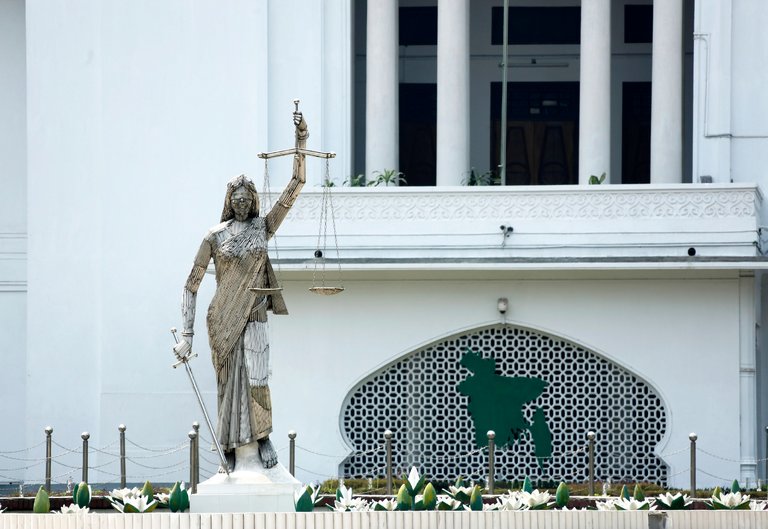Statue of Woman Removed From Bangladesh’s Supreme Court

The statue personifying justice that was removed from outside the Supreme Court in Dhaka, Bangladesh, in the predawn hours on Friday. Credit Abir Abdullah/European Pressphoto Agency
Under pressure from Islamic hard-liners, the Bangladeshi authorities in the predawn hours on Friday swiftly and quietly removed a sculpture of a woman personifying justice from outside the country’s Supreme Court building. The statue had been the target of angry, swelling protests by Hefazat-e-Islam, a vast Islamic organization based in Chittagong, which argued that art depicting living beings was proscribed by Islam.
Hefazat: Remove all idols from public areas
'If anyone tries to build idols, then the Islamic people will give them a proper reply'
Hefazat-e-Islam Bangladesh’s Dhaka Committee chief Nur Hossain Kashemi on Friday demanded removal of all idols from public places in the country.
He made the statement in front of Baitul Mukarram National Mosque after the Jumma prayers. Prior to that, supporters of the Islamic group had staged what they called a “thanksgiving procession.”We will not tolerate any idols on roadsides in the country,” he said.
When later contacted by phone, a representative of Hefazat’s Dhaka Committee could not specify which statues counted as idols.
Kashemi also thanked Prime Minister Sheikh Hasina for removing the Lady Justice “idol” from the Supreme Court premises, which she had earlier committed to doing.
Also Read- In pictures: The removal of SC sculpture
At the programme, Hefazat’s Dhaka city unit Vice-Chairman Mojibur Rahman Hamidi also vowed to ensure that no idols remain in the country in the future.
“If anyone tries to build them, then the Islamic people will give them a proper reply,” he threatened.
Subsequently, the procession leaders held a prayer session seeking a long life for the prime minister.
“Removal of all idols erected in Dhaka, the city of mosques, and elsewhere in the country” was one of the 13-point demands put forward by Hefazat in 2013. The government at that time refused to meet the demand citing constitutional and several international obligations.
Also Read- AQIS supports Hefazat on SC statue removal
Attorney General Mahbubey Alam told the Dhaka Tribune in February: “The demands brought up by the Islamist parties are irrational and baseless. There is no reason to think that the sculpture will be removed just because someone demanded that it be so.”
In February, Khushi Kabir, head of rights organisation Nijera Kori, feared that if this demand was fulfilled, these groups would raise questions about other sculptures such as Oporajeyo Bangla, Raju Bhashkorjo, or Amar Ekushey.
“The demolition of the Lalon sculpture from in front of the Dhaka airport [in 2008] has encouraged the religious zealots to make such demands,” she told the Dhaka Tribune.
But things changed after the prime minister in April said that she too did not like the “idol” installed near the National Eidgah ground.
Also Read- PM: Lady Justice to move to another spot inside SC
Other than Hefazat, an umbrella organisation of Qawmi madrasas led by Hathazari Madrasa Principal Shah Ahmed Shafi who professes death for atheists and demands Shariah law in the country, the Islamist parties and groups opposing the installation of the statue are Awami Olama League, Bangladesh Khelafat Majlish, Islami Andolon Bangladesh and Jamaat-Shibir.
The demand for removing the statue came at a time when the apex court issued two major verdicts – banning the use of scale used by Jamaat as an electoral symbol and erasing the names of 20 convicted war criminals and anti-liberation people from roads and educational institutions across the country.
The High Court on December 12 declared the use of scale as an electoral symbol as it is used in the logo of the Supreme Court. Jamaat’s appeal against the High Court order declaring its party registration illegal is pending with the Appellate Division.
Also Read- Attorney general: Hefazat’s demand irrational
On December 6, the High Court also ordered the government to remove the names of people who campaigned against the independence of Bangladesh during the 1971 Liberation War from roads, installations and educational institutions. The list includes Hafezzi Hujur Road in front of Dhaka South City Corporation which triggered protests by Hefazat and other Islamist parties.
Bangladesh Khelafat Andolan founder Maulana Mohammadullah is popularly known as Hafezzi Hujur.
Ansar al-Islam (previously known as Ansarullah Bangla Team), the pro-Hefazat Bangladesh affiliate of al-Qaeda in the Indian Subcontinent (AQIS), also extended support for the movement.
While members of the militant group expressed solidarity with the demand, they also bitterly criticised Hefazat for sailing on two boats – trying to please the government with soft words and at the same time working to uphold Islam.
Also Read- Hefazat makes good on protest threat, demands SC sculpture removal
Both Ansarullah and Ansar al-Islam have been banned by the government for carrying out a series of targeted killings of war crimes trial campaigners, secularists and LGBT rights activists since 2013, based on lists prepared by the Islamist groups.
After the prime minister recently approved Hefazat’s demand to recognise Dawra-e-Hadith degree as equivalent to a Masters degree in Islamic Studies and Arabic in mainstream education, AQIS members criticised Hefazat for reaching a compromise with the government.